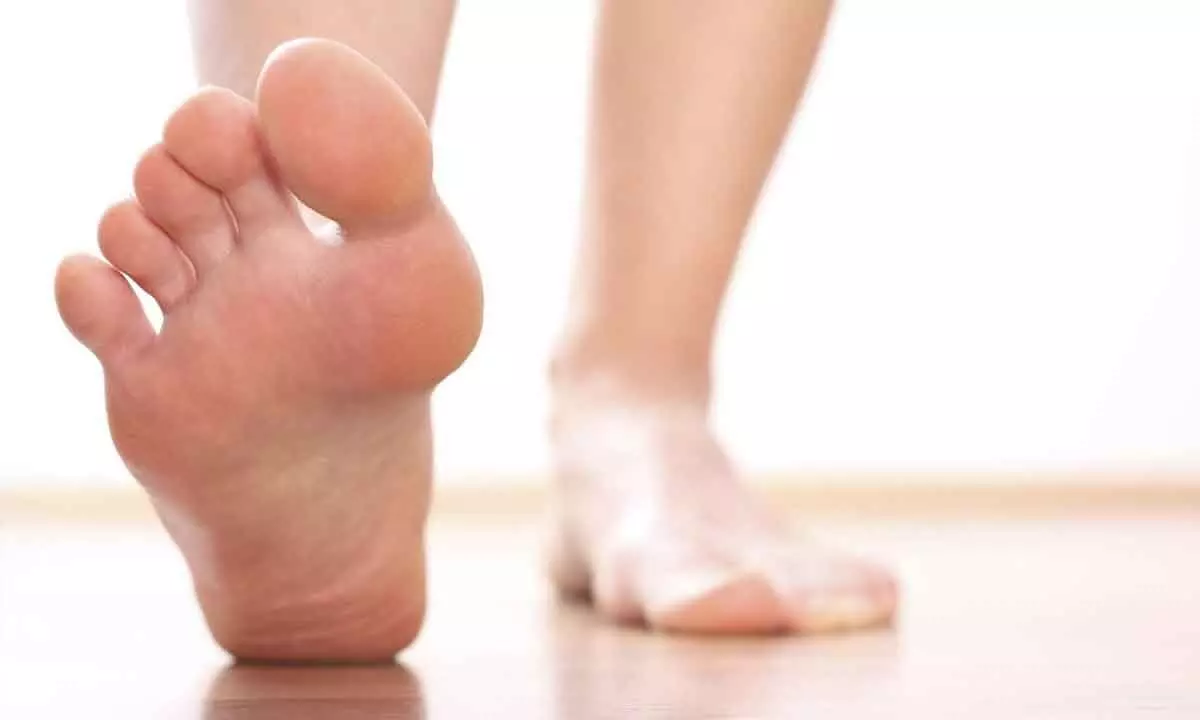Nimble or flat, foot matters most

The left foot is associated with grounding and finding balance in life. It reminds us to stay connected to the earth and maintain stability amidst the chaos. For the majority of people, the right foot stores the past and how one is in the world. The left foot stores more of the internal or self-representation and contains the vital energy for moral and spiritual growth and understanding. Such is the importance of feet that they have become an important part of the lexicon of the English language and are referred to in different contexts and different circumstances
“Her arms across her breast she laid;
She was more fair than words can say;
Barefooted came the
beggar maid
Before the king Cophetua”
– Alfred Tennyson
November 1977. A cyclone and a tidal wave of unprecedented intensity ravaged the coastal areas of (the then) Andhra Pradesh state, especially Krishna and Guntur districts. Such was the fury of the storm that thousands of villages along the coast lay razed to the ground, leaving in its wake a terrible trail of destruction of property and loss of lives.
The rescue, relief and rehabilitation work that followed, by the departments of the state and central governments as well as non-government organisations, drew praise from all over the country and abroad. Unfortunately, however, the difference in political persuasions, at the national and state levels caused the situation to be intensely politicised.
While the primary responsibility for relief and rehabilitation measures rested with the state government, generous support had been extended by the union government through its military and paramilitary forces and administrative agencies.
The politicians, however, were in no mood to let go of the opportunity to extract mileage out of the disaster. One after the other, leaders from Delhi would land in Vijayawada in Krishna district, proceed to the affected areas, return to Vijayavada, hold a press conference and denounce the efforts of the state government in no uncertain terms. So intemperate, embarrassing and tactless was their language that M R Pai, a senior state government civil servant, was constrained to comment, “These chaps have nothing to do but visit the affected area, return, call the press, open their mouths and put their feet in them”.
What follows (hereunder) is a discussion on the importance of the feet of a person.
Think about what your life would be like if you could only walk or stand for short periods of time without pain. The two feet carry a burden and responsibility probably unmatched by any of the other organs of the human body.
The left foot is associated with grounding and finding balance in life. It reminds us to stay connected to the earth and maintain stability amidst the chaos. For the majority of people, the right foot stores the past and how one is in the world. The left foot stores more of the internal or self-representation and contains the vital energy for moral and spiritual growth and understanding.
Such is the importance of feet that they have become an important part of the lexicon of the English language and are referred to in different contexts and different circumstances.
Perhaps, the most common idiom on the subject of feet is the one which refers, to people with a sensible and practical attitude towards life, not entertaining any unrealistic ideas or principles, as those with their feet planted firmly on the ground.
Almost equally frequent is the usage of the word ‘afoot,’ meaning that something is in progress or beginning to happen. The apartment in which one lives, again, is known as a pied-à-terre. Even in the arena of dancing, sport and games, such as boxing or football and cricket, the manner in which a player moves one’s feet is called footwork. If you walk with or have a spring in your step, you walk energetically in a way that shows you are feeling happy and confident. Twinkle toes-used to refer to someone who is a good dancer or who moves lightly on their feet.
The usage goes on. For instance, if you have taken your own sweet time to undertake a task, like I did to decide to write this article, you have been dragging your feet. And if you are so determined to completing a task that you are unable to accept any other engagement till then, you are bound hand and foot to that commitment. If, after you have finished a job to your satisfaction, it does not receive the approval expected from those for whom you did it, you put your foot down, and tell them that either they accept your work or they can simply lump it.
If someone is quick and light in movements and moves in an agile manner, she is said to have nimble feet. If she can also move with good speed, she is a fleet-footed person. If that movement is with a view to competing strongly with someone else, fancying chances of success, she is said to be snapping at the other person’s heels. A person is said to have taken to his heels when running away from someone or a situation, If, further, he runs fast enough to escape, he is called fleet footed and, if, at the end of that chase, he is cornered into submission, he would have no alternative but to fall at the feet of the pursuer. If a person is clumsy or awkward, he or she is called a flat – footed person, or because of the slow and laborious movement, a leaden footed person.
Feet also offer a frame of reference in other contexts. For example, the ideal situation in life is to be able to put your feet up, sit and relax doing no work. And, if you are lucky enough to have so much leisure as to be able to travel freely, and do as you please, on account of a lack, of responsibilities and commitments, you are, quite literally, footloose!
Footwear is considered not only desirable, but also essential, both for the purposes of protection as well as good appearance. Usually, it is those who are unable to afford footwear that are forced to remain barefooted, although not using footwear can also be a habit with cultural roots. I had spent my childhood in Madras, now Chennai. There, and also in Guntur, to which place we moved subsequently, it was common to move about barefoot, largely on account of the warm and humid climate and the cultural norms.
When, following an agitation by the Telugu speaking people of the erstwhile Madras State, a separate Andhra State had been carved out, Kurnool in the new state, became the capital and Guntur the home of the new High Court. My father was a Judge of that High Court and we spent a year and a half at Guntur before, once again, reorganisation of states took place, and the Andhra Pradesh state came into existence with its capital at Hyderabad. It was only after joining the Mahboob College High School in Hyderabad and people looked askance at me that I realised that coming to school barefoot was considered infra dig.
Incidentally, the reference to bare feet by Tennyson, in the poem that appears at the beginning of this article, is to highlight the impoverished condition of the maid.
While on the subject of feet, I remember a joke I read as a college student in the ‘Giant Joke Book’, a very popular compilation of jokes in those days. There is this bakery where fresh bread is baked and sold. The caption of the cartoon shows a couple of well-built men stomping over a mound of flour, apparently for being made into bread, and the sign outside the shop says, “Untouched by hand!”
(The writer is formerly Chief Secretary, Government of Andhra Pradesh)
















